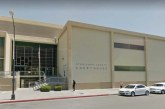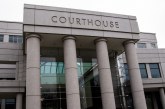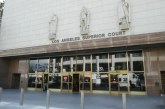 “This case is unprecedented,” the defense begins the first of ten briefs submitted, in closing the challenge to the gang injunction case. “No court has ever issued an injunction under the circumstances presented here.”
“This case is unprecedented,” the defense begins the first of ten briefs submitted, in closing the challenge to the gang injunction case. “No court has ever issued an injunction under the circumstances presented here.”
Do crimes exist in the “Safety Zone”? Yes they do. Are they committed by individuals who are either self-identified or police identified as “Broderick Boys”? There is no disputing it.
Those numbers, however, are not big. The prosecution made a big showing of tacking a red push pin into a map, one for each crime described in the trial. By the of the trial the entire safety zone was filled with red push pins.
It looked impressive until you considered the length of time spanned in which these incidents occurred, and therefore the relatively few incidents that occurred on a per year basis that the prosecution highlighted during the course of their lengthy trial.
The number was 108 incidents, some of which were not even crimes, as in several of them the defendants were either acquitted or not convicted of a gang crime. These incidents occurred from August 2001 to September 2010.
Once you drill down into the incidents, you become less impressed. Many are simply crimes committed by people that the police claim are gang members. Many were not even gang crimes as described in Penal Code 186.22.
The defense cites the number of violent crimes during that stretch as 36 – an average of four per year.
Seventeen of the 108 pins included contacts with individuals who “admitted” to or were believed to be “Broderick Boys,” however no criminal conduct occurred.
29 of the pins identified locations of vehicle stops in which the police discovered drugs or paraphernalia out of public view.
In 57 of the instances, there was only “evidence that only the police witnessed the conduct.”
27 pins placed were assaults were reported to have occurred.
7 pins were placed where firearms or knives were found in a vehicle.
Graffiti was documented on 12 occasions.
Four robberies , three car chases, and one stolen car were all marked.
The most serious of incidents involved the Memorial Park fight that saw six people arrested in relation to a fight which started as a planned one-on-one encounter that quickly escalated.
On April 16, 2007, boys who were drinking beer by the railroad tracks pelted an Amtrak locomotive with stones and seriously injured an engineer who exited the cab to accost the boys. Five youth who were responsible were arrested, convicted, and sentenced to prison.
A fight at Bryte Park occurred on April 19, 2009, at which a pistol was located and two persons were escorted by police to private residences and released.
These are the most serious incidents. There is no drive-by shooting. There is no murder identified. While these individual crimes were violent, in the scheme of gang violence they really are not.
Moreover, the remarkable thing about these incidents is how nearly isolated they were. There is no evidence of an ongoing gang presence that directs these crimes. Instead, it seems to be a series of crimes committed by a bunch of individuals with loose affiliations including friendship, neighborhood, and familial relations to each other.
As the defense writes, “the Plaintiff has made no showing that the crimes were “ongoing” in the sense that they were coordinated by the “Broderick Boys” as a gang, committed with the knowledge of other alleged gang members (unless they were actual accomplices) or committed for the benefit of the alleged gang.”
Thus they argue, “the Plaintiff did not present, and could not present, any evidence that the specific proposed provisions of the injunction – prohibition on constitutionally protected association by “Broderick Boys,” and restriction of their lawful activity by the imposition of a curfew, for example — would operate to prevent, mitigate or deter the criminal activity because of its sporadic, scattered and spontaneous character.”
Instead they argue, “Other than the crimes, there is no showing that the target of the injunction, that is, both the identified gang and its alleged members, were responsible for any public nuisance whatsoever. There is no evidence of any repeated gatherings, minimal evidence of vandalism (graffiti), no evidence of repeated trespass, noise, or the kind of public, disruptive activities that have been the basis of all other gang injunctions.”
How can a judge sustain a gang injunction, take away the liberty of individuals, without due process of law, without a stronger showing?
We sat through the trial, and the DA brought in a series of police officers, all of whom identified specific crimes and contacts with individuals they identify – one way or another – as gang members, members of the Broderick Boys gang they claim.
What evidence do we have that these individuals are gang members?
As the defense shows, there are 103 individuals named as gang members by the plaintiffs. Of these, only fifty-five were alleged to have actually committed crimes.
Again the defense writes, “No evidence of co-ordination, organization, or even simultaneous activity (except for the crimes) by or among the perpetrators was submitted.”
They continue, “Apart from these one hundred and three named persons, no evidence was submitted regarding the ‘active participation’ of other alleged ‘Broderick Boys.’ “
The defense also argues that while many of the identified “Broderick Boys” admitted they were “Broderick Boys,” and the plaintiffs often relied upon the presence of tattoos to establish membership, “there was no evidence that these admissions or tattoos identified the ‘Broderick Boys’ as a criminal street gang as defined by P.C. 186.22(f), or established that these persons knew that it was a criminal street gang. While some alleged Broderick Boys had entered written ‘no contest’ pleas to gang charges or to gang enhancements in criminal proceedings, the documents they signed did not identify the Broderick Boys as a criminal street gang.”
The defense also points out that the classification of inmates as “Broderick Boys” by the Yolo County Jail and other prisons occurs because the “persons were ‘classified’ at the Yolo County Jail as ‘Broderick Boys,’ ‘Northerners’ or ‘Nortenos,’ because of where they came from –the Broderick/Bryte area — not because they were members of any criminal street gang.”
“There was no evidence that association with these groups in prison necessarily entailed membership in a criminal street gang (or even a prison gang),” the defense argues.
To me, watching the trial, there is a good deal of evidence that there are individuals who call themselves Broderick Boys. There is also a good deal of evidence of some sort of affinity with the Norteno Gang/ Nuestra Familia.
Where things become muddied, however, is separating the gang member from popular culture. Moreover, there is no crime in being a member of a gang unless one is committing crimes for the benefit of the gang.
In West Sacramento, there is very limited evidence of such activity.
The defense argues, “Under the First Amendment, courts may not burden the constitutional right of association through a gang injunction unless it is necessary to serve the significant governmental issue of abating an existing public nuisance.”
“No matter how personally repugnant it may be to the court or to the community at large, association, affiliation, and identification of a person as a ‘Broderick Boy’ or ‘Norteno’ is constitutionally protected by the First Amendment,” they continue.
They argue, “The permanent injunction sought by Plaintiff trenches deeply on these protected rights. Because of their importance and sensitivity, Courts have consistently held that restrictions upon association and other protected activity can only be imposed upon clear and convincing evidence that associational activity in itself constitutes a public nuisance.”
And they argue that any evidence that a public nuisance exists is both weak and deficient.
Citing the California Civil Code section 3480, “A public nuisance, by definition, affects ‘at the same time an entire community or neighborhood, or any considerable number of persons … ‘ “
We are again reminded by the testimony of one of the plaintiff’s witnesses. The father of the two Memorial Park “victims,” Reece and James Hopkins, testified that prior to this incident, he had no knowledge of the gang. He lived in the safety zone for years and the only time he became aware of the gang was when his sons got into a prolonged altercation with some alleged gang members.
Instead, we see a case where “perhaps once or twice a year on average, crimes occurred ‘in public,’ but even when ‘in public,’ they were usually not observed by any residents.”
Moreover, many of the crimes had no victims, such as the possession of drugs.
The defense argues, “In a community of some fourteen thousand residents, it cannot credibly be maintained that these incidents, however repugnant, impacted the community or a substantial portion of the neighborhood.”
Moreover, they point out, “nor was there evidence that the presence of a gang called the ‘Broderick Boys’ caused crime in Broderick/Bryte.”
“There was no evidence that the crime rate in Broderick/Bryte was different from communities without identified ‘gang’ members or even unusual in and of itself,” they argue. “There was no evidence comparing the nature, seriousness or rate with which crime occurred in the Broderick/Bryte community to that which occurred in any other part of West Sacramento, Yolo County, or even other cities or counties in the State. In all the cases involving gang injunctions, associational activity by alleged gang members was targeted and restricted by the court because this connection was shown by a high incidence of crime and by gang activity that constituted interference with the quiet enjoyment of property in a compact area.”
The bottom line that I think we have to come to is whether West Sacramento is somehow exemplary, that they need a gang injunction in order to combat the problems caused by the alleged gang and its members. From this trial, we saw a number of incidents, but in the big scheme of things, it was relatively low.
The worst incidents did not rise to the level we have seen in other communities.
People might be tempted to argue that this should be a preventative measure, to prevent it from getting worse, but the law does not allow for that. The law allows for combating a current and ongoing nuisance, not a potential one.
In the end, we are just not convinced that what West Sacramento faces is all that different from what Woodland faces or any number of other communities that have not sought and do not need a gang injunction.
—David M. Greenwald reporting






dmg: “These are the most serious incidents. There is no drive-by shooting. There is no murder identified. While these individual crimes were violent, in the scheme of gang violence they really are not.”
“These …crimes were violent”, but somehow “they really are not”? LOL
Violence is violence, period. That it did not end in murder is something to be thankful for, but it does not make the crimes any less violent.
dmg: “We are again reminded by the testimony of one of the plaintiff’s witnesses. The father of the two Memorial Park “victims,” Reece and James Hopkins, testified that prior to this incident, he had no knowledge of the gang. He lived in the safety zone for years and the only time he became aware of the gang was when his sons got into a prolonged altercation with some alleged gang members.”
It is not uncommon for parents to be clueless/blind as to what their children are up to…
dmg: “In the end, we are just not convinced that what West Sacramento faces is all that different from what Woodland faces or any number of other communities that have not sought and do not need a gang injunction.”
West Sacramento has made great strides in trying to pull together as a community through the nonprofit group B&BCAN (Bryte and Broderick Coummunity Action Network (?)). There was also supposed to be an after school program started in West Sacramento, but I have no idea whether or not that project got off the ground. West Sacramento now has a new City Hall, Community/Sr Ctr, bus terminal, library – all in the same immediate area. Chris Cabaldon must be given credit for making huge inroads in improving this troubled neighborhood.
It will be interesting to see what the judge in this case decides…as to whether the community has made enough substantial changes to the violence there that it is time to lift the gang injunction…
It seems to me that the driving force behind this entire costly trial has been the Yolo county District Attorney’s dependence on identifying increasing numbers of citizens a gang members in order to secure about a third of his budget. There has got to be a better way to fund law enforcement than taking away peoples civil rights in order to cure a problem that does not exist.
The injunction is silly and seems unconstitutional. Focus efforts on charging participants in gang crimes with criminal street gang enhancements, conspiracy, and participation in ongoing criminal enterprises, and put them behind bars for an extended stay.
[quote]The injunction is silly and seems unconstitutional. Focus efforts on charging participants in gang crimes with criminal street gang enhancements, conspiracy, and participation in ongoing criminal enterprises, and put them behind bars for an extended stay. [/quote]
There is a problem with your suggestion. According to the Defense’s expert there is no such thing as a Norteno gang. Therefor anyone claiming to be a member of the Norteno gang could not be charged with a gang enhancement as there is no such thing as a Norteno gang. These individuals are claiming allegiance to something that does not exist. How can you even consider charging someone with a enhancement if they claim to be a member of a gang that doesn’t exist?
Italian mafia members also swear there is no such thing, and RICO statutes have been effectively used on many occasions. The existence of a well organized northern Hispanic gang structure, both in and out of prison, has been verified on innumerable occasions by law enforcement. There is a hierarchy, there are members, and there are actions taken in concert to advance their criminal agenda.
The point in question here is whether that structure exists in West Sac and to this point, no one has shown that it does.
Didn’t Operation Black Widow bring the Nuestra Familia to its knees from an organizational standpoint, anyway? I would imagine there isn’t much of any flow chart now. I know there are also offshoots in the prison system like the Northern Structure, etc. I think David Greenwald says it best. Prove that there is a structure in Broderick. Also, considering that most of the Nuestra Familia’s major players were from San Jose, Salinas, in that area, I’m guessing Sacramento, or as the Nuestra Familia might call it, “Sacra”, isn’t much of a factor. This isn’t really a deep Norteno town. They exist, but only amongst several other gangs, ranging from Crips and Bloods, Asian gangs, Sureno gangs (Southern California Latino gangs that have migrated here, and that have an allegiance to the Mexican Mafia prison gang), etc. I would imagine you probably had more Broderick Boys heavily connected to Nuestra Familia, or any Norteno prison gang, 20 years ago. And, again, I think Black Widow has most of them scrambling to get out of the game and into the “ozzy and harriet” family life, so to speak. That’s what I’m seeing, albeit I’m a lay observer. But as a tax payer and a voter, I’d like to see more than just anecdotal evidence that there truly is a Nuestra Familia (or any Norteno prison outfit) flow chart that extends to Broderick or anywhere in West Sacramento, before we start stripping citizens of some of their basic rights to protect ourselves from it.